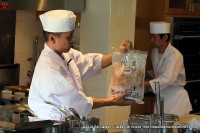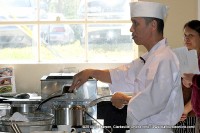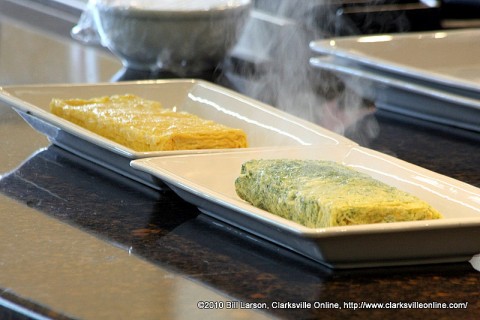 In an exchange of Culture between Japan and the United States, the Japan Foundation and with the Consulate-General of Japan in Nashville, together with the Austin Peay State University Office of International Programs and the APSU History Club hosted a series of events in the Middle Tennessee Area featuring Chef Masahiko Yanagihara, the owner of Sushi Koma in Toyko, Japan. Chef Yanagihara is a master chef with over 33 years experience.
In an exchange of Culture between Japan and the United States, the Japan Foundation and with the Consulate-General of Japan in Nashville, together with the Austin Peay State University Office of International Programs and the APSU History Club hosted a series of events in the Middle Tennessee Area featuring Chef Masahiko Yanagihara, the owner of Sushi Koma in Toyko, Japan. Chef Yanagihara is a master chef with over 33 years experience.

The first program consisted of a demonstration at APSU of some of the traditional forms of Japanese Sushi including: “Bou-Zushi” a primitive form of Sushi consisting of rice wrapped with fish; “Battera” a typical form of Oshi-Zushi, pressed sushi rice with fish on top. In this dish the proportion of Rice to fish becomes larger; “Sasa-Zushi,” a typical leaf-wrapped sushi, that used a bamboo leaf for enhancement of the anti-bacterial effect, this served to keep the contents fresh longer; and “tekone-zushi,” quick lunch box. The typical American image of Sushi is raw fish; and indeed that is a part of some forms of Sushi, however the traditional purpose of Sushi was to help preserve food. The Japanese consider Sushi a food for auspicious occasions.

I was fortunate to be allowed to document the preparation of the ingredients that Chef Yanagihara would use in creating his Sushi that the audience would get to sample, the step by step images are found in the photo gallery below.
The second program was by invitation only, and was targeted at select Culinary professionals from the Middle Tennessee Area. It was held at the Viking Cooking Store in the Factory at Franlin, Tennessee.
Hiroshi Sato, the Consulate General of the Japanese Embassy in Nashville was on hand and introduced Chef Masahiko Yanagihara to the audience.

The program focused on “Dashi,” one of the most basic element of Japanese cuisine. Dashi is a form of soup stock made by combining Kombu Seaweed with Bonito dried flakes.
To understand Dashi you must understand how the Japanese view the flavors of food. In the United States we generally view food as being sweet, salty, sour, or bitter. In Japan they have a fifth flavor called Umami that describes the savoriness of a dish. Umami translates to good flavor or good taste.
Umami results from the bodies ability to detect glutamic acid, an amino acid that occurs naturally in many foods, including meats, cheeses, kombu, and soy sauce. We are more familiar the artificially produced crystalline salt of glutamic acid, monosodium glutamate (MSG), which is often used as a food additive and flavor enhancer in Japanese restaurants throughout America.
Dashi helps to naturally bring out the Umami flavor from foods.
According to Chef Yanagihara, there are three distinct characteristics of Japanese cuisine.
- Expressing the seasons. Japanese food is known for expressing the seasonality of the time. The Japanese enjoy the changing of the seasons and the new opportunities for food it provides. We try not only to express this through the beauty of the ingredients, but in the colors, designs, flavors, dish arrangement that help express the time of the year.
- Respect for tradition. In this day and age we have become a borderless world and you can have food from all the different regions of the world. What makes Japanese food even more Japanese are the traditions that we have built up over the centuries, and still follow through this day. This is a big challenge in the modern day.
- Cooking never lies. This is something I repeatedly remind myself every time. Your cooking will always reflect yourself. That is why it’s always important to continue to build your skills and knowledge over time.
Chef Yanagihara’s mission was to show the audience the essence of Japanese food, and the joy of making the authentic Japanese dishes. “First off I would like to start off by showing you how to make Dashi stock.” he said
In 1980, Shizuo Tsuji. the author of Japanese Cooking: A Simple Art wrote: “Many substitutes for Dashi are possible, but without Dashi, dishes are merely a la japonaise and lack the authentic flavor.” his book is considered to be the authority for those wishing to learn about Japanese cuisine.

“Dashi Stock has become one of the most basic aspects of Japanese cuisine.” he said, “This simple stock has a 1250 year history in Japan, and around 650 years ago they started using kelp as an ingredient. The Key to making great Dashi is the katsuobushi or dried bonito.” Chef Yanagihara said that there are powdered forms of katsuobushi available, but recommended that for the best flavor that broad strips of the dried fish be used instead. “Here is the best kind,” he said holding up the package that he had shipped from Japan.
One of the biggest lessons Chef Yanagihara, has taken from his tour of the United States, was dealing with the local water supplies, “Since I came here I realize that water is a very difficult ingredient to deal with. The water in Japan is a lot softer than the water here, and so it matches the gentle flavors of the Kombu better. The attributes of the water in each regions of the United States that I have been to has been different, each areas water had its own unique strengths and weaknesses.” So for the demonstration they used a bottle of purified water purchased at a local store in place of tap water.

Japanese cooking generally follows the Hikizan (less is more) philosophy, so when you use Dashi in dishes you must balance the flavors. When you add an ingredient that gives more umami, you must substitute a part of the Dashi stock with water in order to balance the flavors.
Dashi stock in a recipe is a process of giving and taking of flavors. When we made the stock for the rice it was 5 parts stock and 5 parts water and one part Saki, and one part light soy sauce, because we added the Oysters to the dish; otherwise we would have used 10 parts stock and no water.
Oysters have a very strong and distinct flavor. If you used the Dashi stock and oysters together it would create a very overwhelming flavor, and you would be unable to enjoy the simplicity of the flavors from the oysters. If you have 5 parts of flavor from the oysters and put that in with 10 parts of flavor from the Dashi stock you would have 15 parts flavor. So in order to keep the flavor even you reduce the amount of stock you add to the dish to remain at the 10 parts flavor that the dish requires.
You still have have a total of 10 parts liquid, so we substituted water which has no flavors of its own.

This is the kind of way you approach Japanese cooking. It’s the perfect way to emphasize the flavor of the oysters. So at the beginning we simmered the oysters to draw its flavors into the stock. We then add the meats to the dish at the end and you have a very tasty rice dish.
Keeping the balance of flavors is very important to Japanese cuisine. That is what I came here to teach you today.
American cooking generally follows the principle of Tashizan (layering flavors on top of flavors).
Chef Masahiko Yanagihara made three very delicious dishes including Dashimaki Eggs, a dish made with eggs and dashi, similar to an omlette; Chawan-mushi, a form of soup with Oyster, Dashi, and eggs; and a delicious Takikomi-gohan, or seasoned rice with oysters.
Although both the Chawan-mushi and the Takikomi-gohan both used oysters as ingredient, the role of Dashi is different. In the case of Chawan-mushi, the flavors are locked in the oysters and are embraced by the eggs and Dashi; whereas in the Takikomi-gohan, the flavor of the oysters is evenly distributed throughout the rice by steaming.



















































